After World War II, the Soviet Union’s political, economic, and military consolidation of Central and Eastern Europe was enforced through a highly visible ideological campaign. Symbols of change and progress were constructed in the form of buildings, bridges, and towers adorned with the Red Star of Communism. Posters of Vladimir Lenin and Josef Stalin ushering in a utopian future hung in classrooms and factories, while statues of triumphant workers reflected that under the Soviet regime, art was used as a tool to educate the masses about the rewards of a collective society. Other propagandistic monuments honoring the Soviet Army’s triumph over Nazi fascism were seen in every park and city square throughout Russia and the Soviet bloc countries in the post-war era. These public works were blatantly symbolic of a new future.

Entrance to Budapest's Statue Park
The fate of these monuments in the post-Communist era, that is, after the 1989 fall of the Berlin Wall and the 1991 fall of Communism, differed in each country of Central and East Europe. Focusing on the monuments of one place, Budapest, one can examine the collective memory of Hungarians through memorialization of their recent history. This former Soviet bloc country has dealt with the symbols of its Communist past in the form of an open-air sculpture museum called Statue Park. Many Hungarians have found this to be a useful though problematic solution for what to do with their Soviet era statues, which reflects collective memory of Hungary’s unique history during the Communist period.

Propaganda Poster of Comrade Rakosi
Hungary is a special example on which to focus because of its history during Communism, which began with practically a dictatorship and ended with relatively good living conditions in comparison to neighboring countries. Mátyás Rákosi, the chief secretary of the Communist Party during the Stalinist period, exercised totalitarian rule over the country and ruthlessly persecuted innocent people deemed to be “state enemies” with his special police force. No other leader was trusted more by Stalin, and Rákosi developed a cult of personality with his images and statues spread throughout the country to remind everyone of his “wisdom”.
With a failing economy, poor living conditions, and virtually no freedom of speech, student demonstrators attempted to regain control of their own government with both large and small demands during the 1956 Revolution. In addition to demanding the removal of the Soviet troops and insisting on the right to free press, Hungarian revolutionaries insisted upon many symbolic changes, such as the replacement of the Soviet military uniforms with the old Hungarian style uniforms, the restoration of national holidays, and the coat of arms switched back to tradition. Visible symbols are extremely meaningful and as in the words of George Schöpflin, the ‘use of flags, monuments and ceremonies is not a superfluous extravagance, but a central component of identity creation and maintenance”. Although the Revolution worked for a short time, within weeks the Soviet Army regrouped and returned to control Hungary with a vengeance. Many of the demonstrators were killed or injured, and after the Soviet Union regained control, thousands were imprisoned for having participated in the rebellion, and over two hundred people received the death penalty. Until the fall of Communism in 1991, the records of this Revolution were hidden in Hungary and Hungarians were not permitted by the government to mention the events that took place in 1956.

1956 Hungarian Revolution
By the mid-1960s, life in Hungary improved with János Kádár as prime minister. He conducted a great deal of counterrevolutionary terror in the beginning years of his political office, but he also reorganized and reformed the Communist government. In contrast to Rákosi, Kádár worked under the motto of “who is not against us is with us” and populations of other communist countries looked at developments in Hungary with envy. He produced a set of economic reforms and allowed peasants to own private plots of land and to sell their products at uncontrolled prices in an open market. The country’s economy thrived and Hungary had many goods and amenities not available in neighboring countries. Greater value was placed on public opinion and human rights improved. Often the period under Kádár with its mix of ideologies is referred to as “goulash communism” which is a witty pun on the national dish with many ingredients.
This unique communist history of Hungary influenced the debates that emerged over what to do with the Soviet-era monuments that still spread throughout the capital city Budapest in 1991. Statue Park, one solution to the Soviet monument problem, is a physical manifestation of the mixed feelings Hungarians have towards their communist past. Budapest’s post-Communist city authorities were divided over the question of what to do with the most visible symbols of the old Soviet regime. Numerous statues and monuments stood throughout the city honoring both Soviet and Hungarian Communist leaders and many suggestions were proposed for how to handle these symbols”. One group campaigned to have all of the statues removed in order to cleanse the city of Communist traces. A more extremist group threatened to blow up the statues if they were not taken away. Yet another group thought the statues should remain in their respective places as reminders of Hungary’s experience with the Communism, which helped to shape its history. There were many residents of Budapest who did not care one way or another.
In December 1991 the General Assembly of Budapest reached a decision. Each individual district of Budapest would decide for itself which of the statues were to be removed and which would remain in place. This process exemplified the new democracy in Hungary. If a district opted to have the statues removed, they would not be destroyed; rather, they would be relocated to Statue Park, the new sculpture park on the outskirts of the Budapest. The cost of relocation was estimated at an exorbitant $616,000 due to the sheer size and massive weight of the Soviet style public sculptures. However, Budapest city authorities predicted that these costs would be recovered by the financial gains of a sculpture park that could tap into the huge foreign tourist boom that the city was experiencing since the fall of Communism.

Ariel View of the Design of Statue Park
A competition called for designs for Statue Park, and the Hungarian architect Arkos Eleod was chosen democratically through a juried selection process. Eleod’s intention was to create a park both politically and artistically neutral, neither celebrating nor condemning Communism. His purpose was to acknowledge the statues as part of the history of Hungary. Eleod did not want to create a park to express his own anti-propaganda message, as he did not want to erase the original meanings of the sculptures. Although Western critics have unfairly labeled Eleod’s park a “theme park,” Statue Park was intended to be and succeeds at being an open-air museum that thoughtfully commemorates a significant aspect of modern Hungarian history.
Statue Park, built on a half-acre of land in southern Budapest, opened to visitors in 1993. Despite its name, the open-air museum contains more than just statues. It consists of a wide variety of monuments from the Communist period, most dating from after the 1956 Revolution. Of the forty-one sculptures in the space, seventeen are statues or busts, thirteen are memorial plaques and the remaining eleven are metal or stone monuments. Situated near the entrance of the Park are the sculpted boots from the Stalin monument that the 1956 revolutionaries demanded to be removed and ultimately chopped down at the knees. For several days after the Revolution, Stalin’s disembodied boots symbolically stood on their pedestal, as they do today near the entrance of Statue Park.

Stalin's Boots Through the Entrance of Statue Park
The carefully designed Statue Park assigns these re-located massive statues new meanings. Considerable attention was given to the organization of the Park so that it would avoid looking like a dumping ground for old memorials. The design and layout contains many references to the Soviet period. Statues of Marx and Lenin stand within an imposing façade at the entrance. The red brick structure mocks Neoclassical Socialist Realist architecture, a style that aimed to make Russia “a natural successor to classical architecture but on its own legitimate terms”. The Park itself is arranged with figure eight-shaped pathways that radiate off one central straight pathway. The statues and monuments are displayed around these figure-eights. In the center of the Park, there is a flowerbed that forms the shape of a Soviet star. Whichever direction visitors walk, they are led back to the same starting point. The central pathway that abruptly leads to a brick wall is essentially a dead end. This obstacle, along with the whole layout, according to historian Duncan Light, represents the “dead end” that Communism represented for Hungary.
Based on Western museum models, Statue Park is owned by the city of Budapest but operated by a private company. The company charges a small admission fee and manages the modest souvenir shop. The shop sells t-shirts with anti-Communist slogans, lighters depicting Lenin’s face, CDs of Communist music, as well as assorted candles, postcards, and posters. One poster, as a spoof on the cartoon South Park, features Communist figures Lenin and Stalin standing in what is labeled “East Park”. Such clever merchandise tempts the many Western visitors to the Park. Yet the souvenirs are not the only reason tourists come to Statue Park. Many foreign visitors come to this unusual tourist attraction to gain a deeper understanding of Budapest’s history. Their seriousness is revealed by the fact that they must seek out a bus to travel about 30 minutes from the city center to get to the Park, located in an out-of-the-way district of the city bordering a working class, industrial suburb.

Graveyard for Fallen Monuments, Russia

Graveyard for Fallen Monuments, Russia
Statue Park, while unique in many ways within Central and Eastern Europe, is not the only park of its kind in former Communist countries. Both Russia and Lithuania have placed their respective Communist statues in parks as well. Neither the Russian nor the Lithuanian park functions as an outdoor museum, and the Russian park does not appear to be as well planned as Statue Park. In Moscow, Russian officials placed some Communist-era monuments in a park named ‘Graveyard for Fallen Monuments’. Here, a few Communist statues are haphazardly displayed among hundreds of other monuments that have little to do with the politics of the Soviet era, many perhaps commissioned during Lenin’s public art campaign in 1918. All the statues have been removed from their original locations and dispersed throughout a grassy field. This carefree atmosphere detracts from the Communist statues, which are inexplicably placed next to sculptures of cats, Ghandi, and other subjects. The seemingly arbitrarily chosen and arranged statues suggest to visitors that Russia is brushing over its Communist history.
The Lithuanians have taken a more methodical approach with their outdoor statue display called Grutas Park. Coined “Stalin World” by the locals, the park presents Lithuania’s Soviet-era statues along a beautifully landscaped path surrounded by lush trees and a lake. In addition to this open-air display and an outdoor gallery, Grutas Park is also host to an amusement park, a playground, a campsite, and even a zoo. In this context, the Communist statues become part of a “Disneyesque” entertainment park, which in turn diminishes the seriousness of the Lithuanian effort to memorialize its history.

Grutas Park, Lithuania
James Young studies the ever-evolving relationship between a state and its memorials. He writes that, “on the one hand, official agencies are in position to shape memory explicitly as they see fit, memory that best serves a national interest. On the Other hand, once created, memorials take on lives of their own, often stubbornly resistant to the state’s original intentions”. Although speaking of Holocaust memorials, these sentiments are true for the memorials in Statue Park. The Communist authorities created the Soviet-era statues in Statue Park for propagandistic reasons. In post-Communist Hungary, new meanings are assigned to these “leftovers” that reflect the new independent state. Statue Park, the carefully constructed site of these statues, acts as a memorial in itself. As Young explains, “New generations visit memorials under new circumstances and invest them with new meanings” . Statue Park allows for a location for this act of collective identity construction. As a place to reflect, the park shows Hungarian’s mixed feelings of the country’s recent past.
A preliminary interpretation of Budapest’s Statue Park asserts that the creation of such a park reflects Hungary’s confidence in the post-Communist era. The Park suggests that the country is accepting of its past and wants to remember this critical period in its history. Despite Hungary’s initial debate over what to do with the Soviet-era monuments throughout Budapest, there was surprisingly little protest over the construction of Statue Park. This acceptance of the Park reflects the country’s history of “goulash communism”, which was a mix of ideologies and not communism in the strictest sense. Although Hungary had a harsh dictator for the Stalinist era, by the mid-1960s life in the country improved in comparison to neighboring countries. With this history of political extremities, collective memory of communism in Hungary reflects mixed sentiments, as shown in Statue Park. The National History Museum in Budapest, another popular tourist destination, seems to take a similar stance of acceptance of communism, but one that is also tempered with historical amnesia. Opened in 1996, the museum contains a gallery that includes patriotic posters, a statue of Stalin, and displays on the gradual collapse of Communism over many decades. The artifacts are presented as symbols of how Hungary overcame Communism but with little mention of the hardships the country endured.
Upon further consideration, Statue Park also represents how Hungarians are uneasy with their communist history. The Park was built on the outskirts of Budapest, so that only the most dedicated of tourists will visit. The statues were removed from the most prominent locations around the city to the periphery. Although the park was carefully designed, the location alone shows that Hungarians are not entirely accepting of their communist past. Although the economic situation in Hungary prospered after the mid-1960s and many consumer goods were available that were non-existent in neighboring countries, people did not have the freedom of expression of a democratic society. For example, people were not allowed to speak of the Hungarian Revolution of 1956 throughout the communist years or they would be considered subversive.
Statue Park promotes this multi-faceted way of remembering the Soviet period, as the sculptures carry meanings from their original contexts in the streets of Budapest and assume new, more critical meanings from their placement in the Park. Some native Hungarians are perplexed and even saddened that Statue Park draws such tourist appeal. Perhaps these are the Hungarians who wish to ignore or erase the Communist period of their history. However, other Hungarians are attracted to the nostalgia the Park offers. For decades, Communism was the only life they knew. Germany has a term for this sentiment: ostalgie. The word, which is a combination of ost for east, and nostalgie for nostalgia, describes an East German longing for items that were no longer sold after the fall of the Berlin Wall and the reunification of East and West Berlin. Some East Berliners missed specific food brands and old television shows, which led a re-unifed Germany to cater to this market, despite the fact that these products symbolize oppression under a former Socialist regime.
With regard to Statue Park, this concept of ostalgie comes into play most overtly with the souvenir CD of Communist propaganda songs that is sold at the gift shop and played over the loud speakers in the Park itself. The shop originally released the CD, which satirizes the Soviet era and presumably expresses disdain for that time. Ironically, the album is loved by young Hungarians and reached number one on the Hungarian music charts. This suggests that feelings towards Communism in Hungary are not only complex and but that the meanings of Statue Park and its merchandise are far from monolithic.

Statue Park Logo
Statue Park can be seen as an ideal way for a country like Hungary to at once remember its past and look to the future. Statue Park symbolically overcomes the Soviet era without ignoring it completely. The outdoor space keeps the memorials in a contained area removed from the city center. Hungarians and foreign visitors who were once confronted constantly with the Communist statues throughout central Budapest must now make a special trip to the outskirts of the city to seek out the experience. Tourists can make the trip, as can nostalgic, curious, or historically conscious Hungarians. By displaying the individual memorials in a closed-off space, far from their original locations, the Park allows Hungarians to preserve their history but also put it in its place. Although Hungarians remain ambivalent and divided about Statue Park and their own unique Communist history, they are confronting their past in ways that suit their cultural needs and political ambitions. Statue Park, in its strategically chosen location and well-thought out design, reflects Hungary’s desire to compartmentalize its past while forging ahead with its future.
Click below for a list of my resources for this post…
statue park bibliography


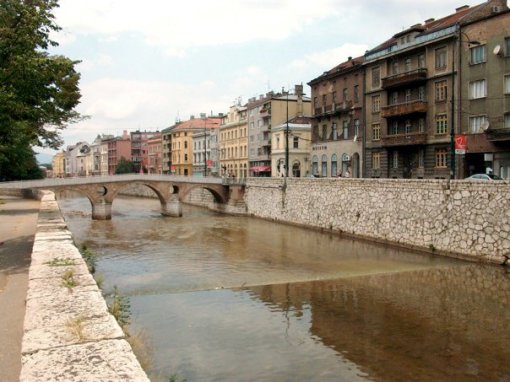














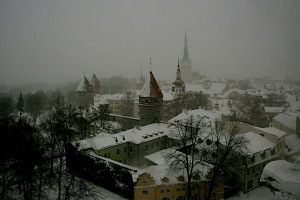

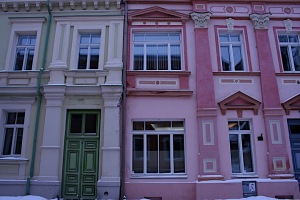



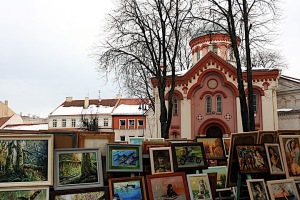








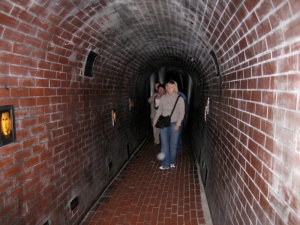
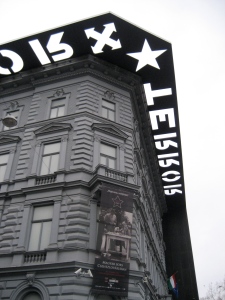 Facade of House of Terror, Budapest Hungary (no photography allowed inside museum)
Facade of House of Terror, Budapest Hungary (no photography allowed inside museum)
